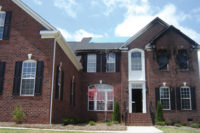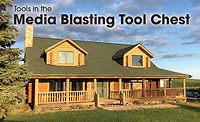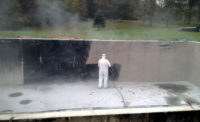
Image 1
Given the opportunity to ask any question about media blasting, most interested individuals ask about the application. “When do you apply blasting?” “What situations call for which blast media?” “Why would one application be successful, and another a losing battle?”
Understand application, and you understand blasting. When asked, I find it best to use examples of applications to highlight the success of one blast process or another. When a restoration contractor ventures into the world of media blasting – typically using exotic, sometimes-uncooperative, blast media like baking soda, or dry ice – he never knows where he’ll end up. Some jobs are “textbook” blasting jobs: easy to see the proper application with very little question. Other applications require a little more ability to think “outside the box.” Experiences, whether first-hand, or gathered from others, help to guide our future applications.
Good examples, those filled with the proper information, can put you in someone else’s shoes to learn from their experiences – good and bad.

Image 2
This application involved a major fire loss mostly within a large brick home in a beautiful South Carolina suburb (Image 1). After the initial tear-out, it was obvious that the home had severe fire damage throughout the structure. The fire took place on the second floor of the home with severe damage to certain areas of the roof and attic above.
Smoke and soot damage were widespread throughout the remaining roof, trusses, attic, the second floor, and to a lesser degree even the first floor. The restoration contractor – experienced enough to recognize the extent and severity of this loss – knew that a novel approach would be required.

Image 3
The manual removal approach is tedious, expensive, and often lacks a truly effective end-result. Further, there were areas of the structure where tools like sanders and brushes would have had problems. Problem areas included portions of the attic with OSB roofing material and its thousands of protruding roofing nails, and the complex wooden framework of the home, interwoven with communications and electrical wiring. In fact, one of the experienced sub-contractors on the job recommended tearing out and re-building large portions of the structure, including the roof and attic – a viable, but very expensive, option.

Image 4
After some consideration and research – including contacting a few of his peers for a recounting of their experiences – the contractor chose baking soda blasting for the application.

Image 5
Baking soda blast media also offers significant odor reduction. This media is a “buffering” agent, neutralizing the strong pH, and at the same time the odor potential, of soot and smoke residues. With proper, in-the-field training, the contractor was quickly up and blasting (Image 2). Areas of heavy damage were cleaned effectively using this process (Image 3). The baking soda even proved effective at cleaning the masonry on the exterior of the structure.

Image 6

Image 7
That “something” turned out to be an improvised basketball court on the back patio. A little red spray paint and this tenant was able to provide his sporting guests with not only a free-throw line, but a three-point line, a center-court circle and even a little support for the local b-ball team in the way of the “D A” graphics (Image 5 and 6).

Image 8
One of the side effects to wet blasting is that the clean-up method must also be wet. In this case that meant rinsing with large amounts of water, easily provided by the same garden hose that provided the nozzle water. The water-soluble, baking soda media posed no environmental problems and was simply rinsed away.
Relying on assurances by the manufacturer that damage to the concrete would be minimal, the contractor used a “fan” shaped nozzle at 60 PSI to clean the lines and paint markings. It was then necessary to clean the entire patio lightly to match the previously cleaned areas. The entire process took less than half a day for the two-person crew (Images 8 and 9).

Image 9
Our last example took place just north of the border in Canada, but could be found in almost any part of North America. What sets this application apart is that it was a mold remediation job that was paid for by an insurance company that does not cover “mold” in its policies. Increasingly insurance companies are limiting their exposure to losses caused by mold damage.

Image 10
One of the problems with these operations is that the indoor greenhouse that is created is very warm, and very humid – ideal conditions for mold growth. This is often coupled with the fact that grow ops are very often set up in properties where the operator grows for a “season” or two, and then moves on to avoid detection. Little care is given to the protection of the structures in these situations, and the mold damage left in their wake can be severe.
Such was the case here. And although the insurance adjuster steadfastly refused to refer to the damage as “mold,” he understood the need to remediate the structure of the “greenhouse damage.”

Image 11
When blasting with dry ice there is no secondary waste. In a job where “mold remediation” was officially not taking place, the less clean up (and the cost associated with it) the better. And while cleaning of the “primary” waste is still necessary, usually with HEPA vacuums, the amount of cleaning and volume of waste is significantly less than with other blasting methods.
As with many experiences there are things to be gained from failure as well as success. In this particular case, the lesson concerned the logistics of dry ice. Dry ice pellets are perishable and as such they are made to order – as much, or little, as you’d like. Order carefully because large boxes of dry ice can be difficult to handle on the jobsite, as well as back and forth. (Image 10)
Also, because of the logistical complexities of dry ice, purchasers tend to err on the side of having too much dry ice on hand rather than too little. Extra ice is never returned for credit. It’s never stored for the next job (Image 11). Extra ice is simply waste; therefore, estimate and order carefully.
Hopefully these examples have provided a little insight into the business of restoration with blasting. Blasting is like most tools in the restoration business: the more experience we gain, the better we become at our craft.
Experience can be our best source of knowledge. Ask around, “borrow” someone else’s experience, and get some of that important information. Ultimately, though, we have to get out and make our own way. In the architectural restoration business, one sure way to make things happen is with media blasting.




Report Abusive Comment